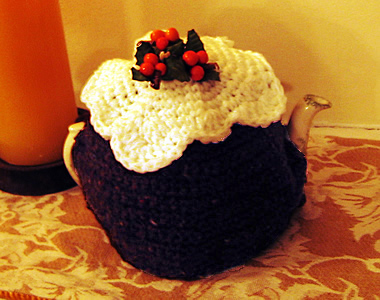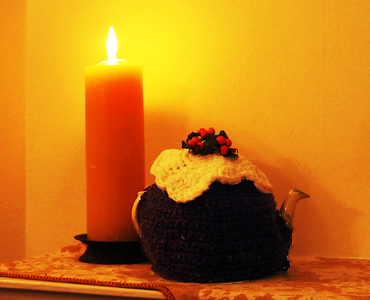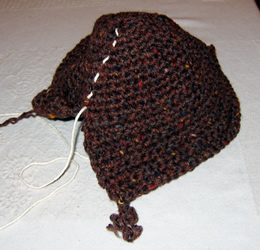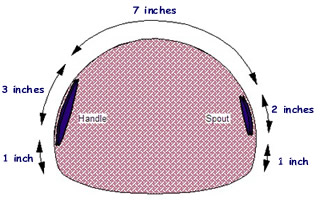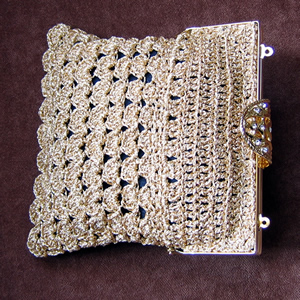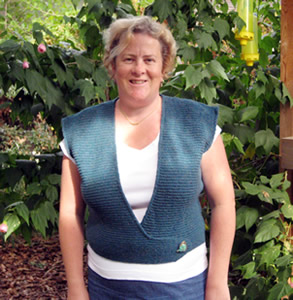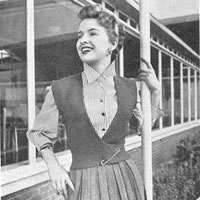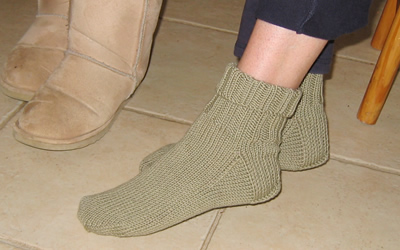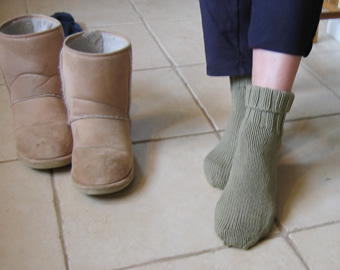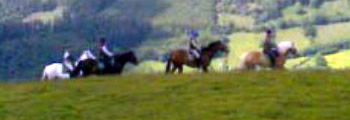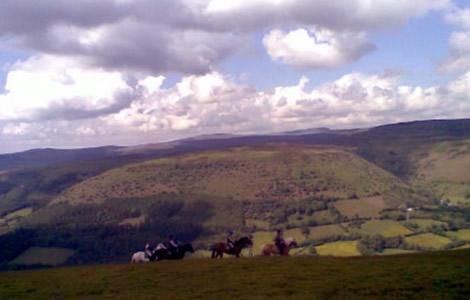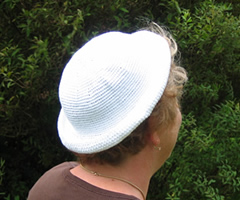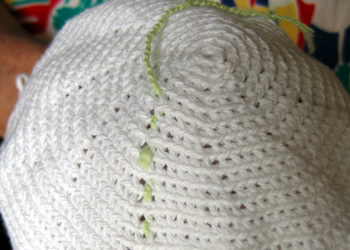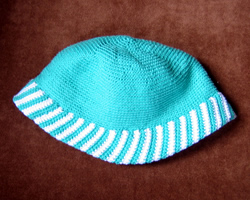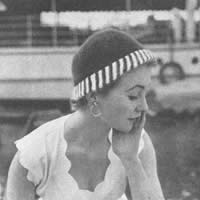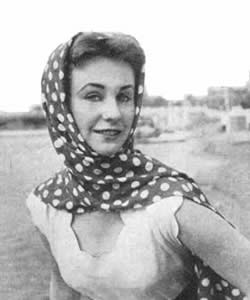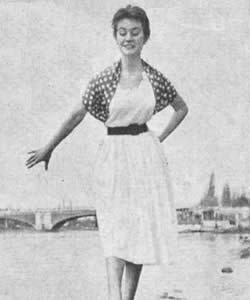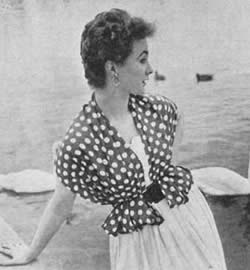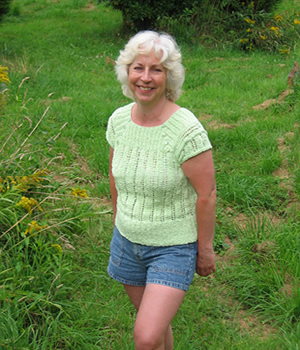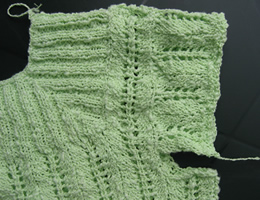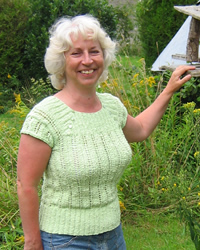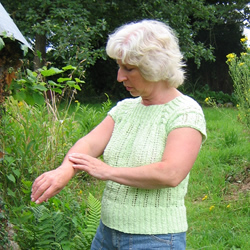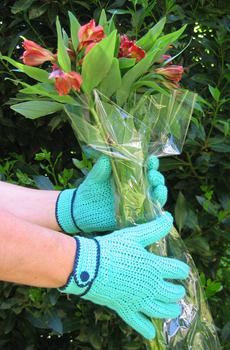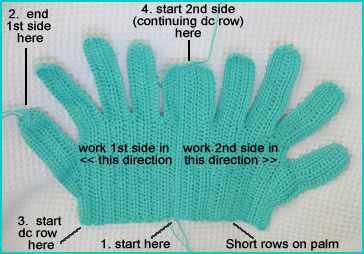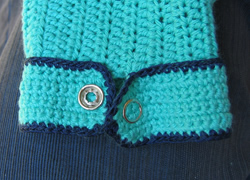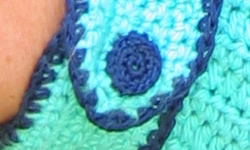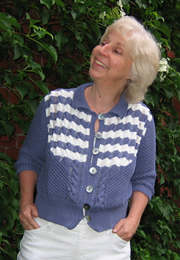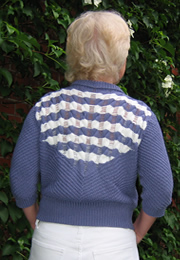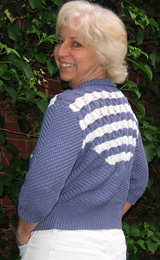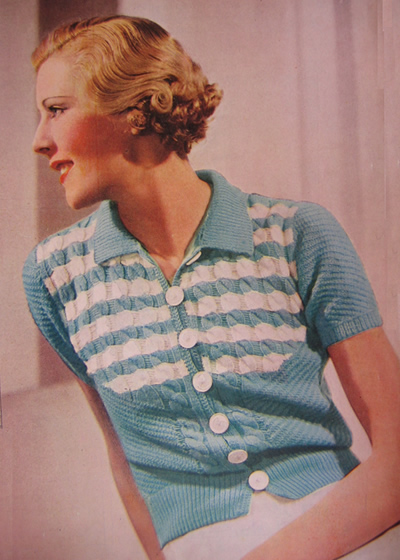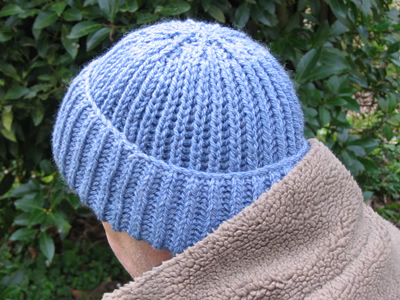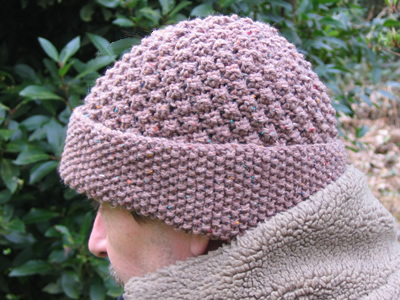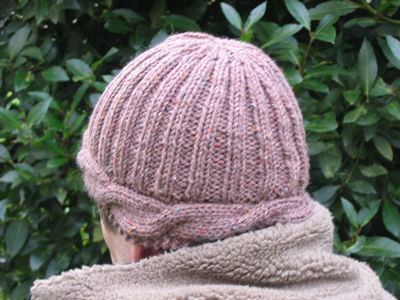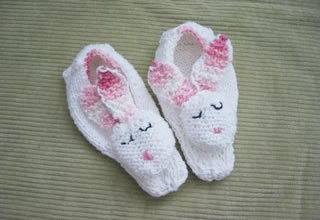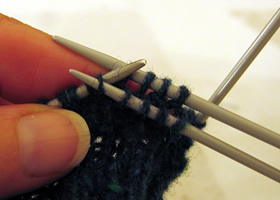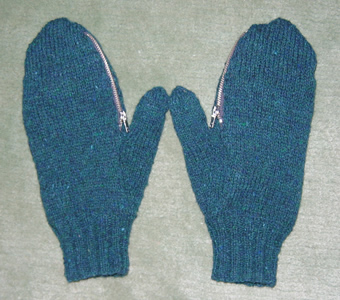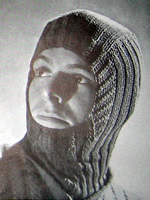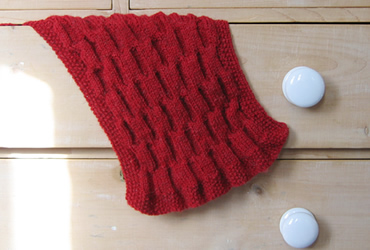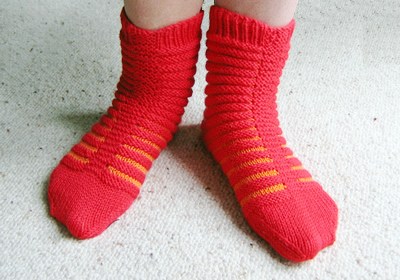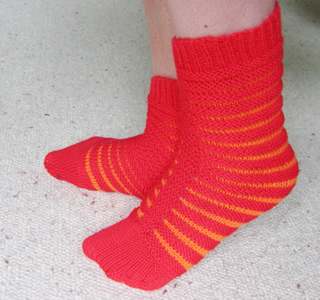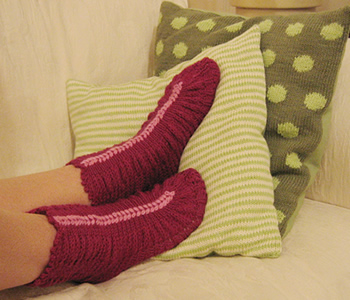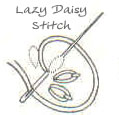Diagonal Rib Pattern
Sleeves and lower part of jumper are knitted in a k2, p2 rib, with the
rib carried one stitch sideways on each row.
The following 4 rows form the pattern, worked over an odd number of stitches.
Row 1: (k2, p2) repeated to centre
stitch; knit centre stitch; (p2, k2) repeated to end of row.
Row 2: p1, (k2, p2) repeated to centre
5 sts; k2, p1, purl centre stitch, p1, k2; (p2, k2) repeated to last st,
p1.
Row 3: (p2, k2) repeated to centre
stitch; purl centre stitch; (k2, p2) repeated to end of row.
Row 4: k1, (p2, k2) repeated to centre
7 sts; p2, k1, purl centre stitch, k1, p2; (k2, p2) repeated to last st,
k1.
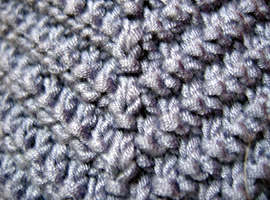
Cable Pattern
The yoke of the jumper is knitted in cable ribbing, where the stitch
between the cables is subsequently dropped to form "ladders".
To work the 8-stitch cables twisting to the right, (cable "back"
abbreviated to C4B), slip 4 sts on to a cable needle, and leave at back
of work, k4, then k4 from cable needle.
To work the 8-stitch cables twisting to the left, (cable "front"
abbreviated to C4F), slip 4 sts on to a cable needle, and leave at front
of work, k4, then k4 from cable needle.
When the sts are dropped, pull them back to where you started the cables,
above the diagonal rib, and secure the stitch by running a thread through
and stitching on the inside.
[Editor's note: Be
extra careful with the bamboo yarn; it is very slippery, the ladders run
very easily, and the yarn splits, making it the devil to pick up a stitch
dropped accidentally.]
Back
Using No. 12 needles and main colour (blue), cast on 104 stitches, and
work 3 inches in k1, p1 rib, (approximately 25 rows), increasing one stitch
at the end of the last row.
Change to No. 9 needles and purl one row. [105 sts]
Work the 4-row pattern 10 times,
then the first two rows again, (42 rows).
[Editor's note: The
origonal instructions were to work the 4-row pattern 14 times as it was
intended for a thinner yarn. For my version, in the bamboo yarn, I worked
16 rows fewer up to the start of the cables, as well as 16 rows fewer
in the armhole section (see notes below) which brought the welt up to
sit on my hips as shown in the photo.]
Row 43: (p2, k2) repeated to centre
stitch; knit centre stitch; (k2, p2) repeated to end of row. (ie
pattern row 3 with 5 sts knitted in the middle).
Row 44: k1, (p2, k2) repeated to centre
7 sts; p7 centre sts; (k2, p2) repeated to last st, k1. (ie pattern row
4 with 5 sts knitted in the middle).
Row 45: (k2, p2) repeated to centre
9 sts; k9 centre sts; (p2, k2) repeated to end of row.
Row 46: p1, k2, (p2, k2) repeated
to centre 11 sts; p11 centre sts; (k2, p2) repeated to last 3 sts, k2,
p1.
Row 47: p2, (k2, p2) repeated to centre
13 sts; k13 centre sts; (p2, k2) repeated to last 2 sts, k2.
Row 48: k1, (p2, k2) repeated to centre
15 sts; p15 centre sts; (k2, p2) repeated to last st, k1.
Row 49: (k2, p2) repeated to centre
17 sts; k17 centre sts; (p2, k2) repeated to end of row.
Row 50: p1, k2, (p2, k2) repeated
to centre 19 sts; p19 centre sts; (k2, p2) repeated to last 3 sts, k2,
p1.
Row 51: p2, (k2, p2) repeated to centre
21 sts; k21 centre sts; (p2, k2) repeated to last 2 sts, k2.
Row 52: k1, (p2, k2) repeated to centre
23 sts; p23 centre sts; (k2, p2) repeated to last st, k1.
Row 53: (k2, p2) repeated to centre
25 sts; k25 centre sts; (p2, k2) repeated to end of row.
Row 54: p1, k2, (p2, k2) repeated
to centre 27 sts; p27 centre sts; (k2, p2) repeated to last 3 sts, k2,
p1.
Now start the striped pattern:
Row 55: K38 sts in pattern as set
in blue; join on white: k6, cable C4B, k1, cable C4F, k6; join on another
ball of blue and finish row in pattern.
Row 56: Pattern 37 sts blue; purl
31 white; pattern k37 sts blue.
Row 57: Pattern 36 sts blue; knit
33 white; pattern 36 sts blue.
Continue as on last 2 rows. increasing number of white stitches for 5
more rows (i.e.. finally 31 blue; 43 white; 31 blue).
Row 63: Work in blue right across
row: 30 sts in pattern; k5, (C4B, k1) twice, (C4F, k1) twice, k4; 30 sts
in pattern.
Row 64: Pattern 29 sts; p47; pattern
29 sts.
Continue thus for 6 more rows in blue, still taking 2 more into stocking
stitch in each row (23 pattern sts on each side).
Row 71: Pattern 22 sts blue; join
on white: k4, (C4B, k1) 3 times, (C4F, k1) 3 times, k3; join on blue pattern
22 sts.
Row 72: Pattern 21 sts blue; purl
33 white; pattern 21 sts blue.
Continue thus for 6 more rows.
Row 79: Work in blue right across
row: 14 sts in pattern; k3, (C4B, k1) 4 times, (C4F, k1) 4 times, k2;
14 sts in pattern.
Row 80: Pattern 13 sts; p79; pattern
13 sts.
Shape armhole:
Rows 81 & 82: Still taking one
stitch more at each side of centre piece, cast off 3 sts at beginning
of next 2 rows.
Rows 83: k2tog at beginning and end
of row.
Row 84-86: Work 3 rows in pattern
without decreasing.
**
Row 87: Change to white: k4, (C4B,
k1) 5 times, (C4F, k1) 5 times, k3.
Continue in stocking stitch for 7 rows.
Repeat from ** with alternate colours 4
times, then repeat row 87 row in blue.
[Editor's note: The
original pattern on thinner yarn repeated the pattern 6 times here. I
worked a shorter arm hole here which worked out for my own measurements
- see section on sizing. You can work the armhole to a suitable length
according to your size and your yarn; however, if you do make alterations,
remember to work the same length on the fronts, and prepare to do some
compensation on the sleeve decreasing.]
Work 3 rows in stocking stitch.
Row 131: Cast off 2, drop 1 st, leave
big loop (to cover dropped st), and cast off 1 more; knit to end.
Row 132: Cast off 2 purlwise, drop
1 st, leave big loop (to cover dropped st), and cast off 1 more; purl
to end.
Row 133: Cast off 7, drop 1 st, cast
off 1 more very loosely as before; knit to end.
Row 134: As 149th row but purl.
Now cast off remaining sts, dropping stitches between cables.
[Editor's note: You
may want to catch the all the dropped sts with safety pins at this point
in the construction, until you are ready to sew up and secure the sts
in the right place.]
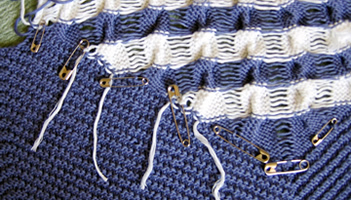
Right Front
Using No. 12 needles and main colour (blue), cast on 66 stitches, and
work 3 inches in k1, p1 rib, (approximately 30 rows), increasing one stitch
at the end of the last row. [67 sts].
Change to No. 9 needles and purl one row.
Row 1: k15; (p2, k2) repeated to
end of row.
Row 2: p1; (k2, p2) repeated to last
14 sts; k1, p13..
Row 3: k. 13, p2; (k2, p2) repeated
to end of row.
Row 4: k1; (p2, k2) repeated to last
14 sts; p14.
Row 5: k4; cable C4F; k3; (p2, k2)
repeated to end of row.
Row 6: p1; (k2, p2) repeated to last
14 sts; k1, p13.
Row 7: k. 13, p2; (k2, p2) repeated
to end of row.
Row 8: k1; (p2, k2) repeated to last
14 sts; p14.
Repeat these 8 rows 4 times.
[Editor's note: The
original pattern on thinner yarn repeated the pattern 6 times here. I
worked a shorter length here to match the back]
Row 41: k15; (p2, k2) repeated to
end of row.
Row 42: As 2nd but purl last 16 stitches.
Row 43: k17; p2, (k2, p2) repeated
to end of row.
Row 44: As 4th but purl last 18 stitches.
Row 45: k4; cable C4F; k7; (p2, k2)
repeated to end of row.
Row 46: As 2nd but purl last 20 stitches.
Row 47: k. 21; p2; (k2, p2) repeated
to end of row.
Row 48: As 4th but purl last 22 stitches.
Row 49: k.23; (p2, k2) repeated to
end of row.
Row 50: As 2nd but purl last 24 stitches.
Row 51: k25; p2; (k2, p2) repeated
to end of row.
Row 52: As 4th but purl last 26 stitches.
Row 53: Join in white: k4; cable
C4F; k1; cable C4F; k6. Join in blue: (p2, k2) repeated to end of row.
Row 54: As 2nd. ending k. 2. Purl
last 28 stitches in white.
Continue for 6 rows in pattern, working 1 more stitch in white on each
row.
Row 61: All blue. K4, (C4F, k1) twice,
C4F, k5; (p2, k2) repeated to end of row.
Continue for 7 more rows as before, working 1 more stitch into stocking-stitch
border in front on each row.
Row 69: Join in white: k4; (C4F,
k1) 4 times, k3. Join in blue: (p2, k2) repeated to end of row.
Continue for 7 more rows as before.
Row 77: All blue. K4, (C4F, k1) 5
times, k2; (p2, k2) repeated to end of row.
Continue as before for 4 more rows.
Shape armhole:
Row 82: Cast off 5, k1, p2. k2, purl
to end.
Row 83: Knit to within 5 from end,
p2, k1, k2tog.
Row 84: K2tog, k1, purl to end.
Row 85: Join on white: k4; (C4F,
k1) 5 times; k9, k2tog.
Row 86: P2 tog, purl to end. [58 sts]
Row 87: Knit to last 2 stitches, k2tog.
[57 sts]
Row 88: P2 tog, purl to end. [56 sts]
Repeat the last 2 rows twice more.
Row 93: All blue. K4; (C4F, k1) 5
times; k3. [52 sts]
Work 7 rows stocking stitch.
Work 2 more cable stripes alternately
in white and blue, working only 3 rows in stocking stitch after the cable
row on the second blue stripe.
[Editor's note: The
original pattern on thinner yarn repeated the stripes 4 times here, working
3 rows on the 4th stripe. I worked a shorter armhole here to compensate
for the heavier yarn weight as on the back - see sections on wool and
sizing.]
Row 113: Cast off 2, break wool and
pull through last stitch; drop 1. Join on again.
[Editor's note: You
have effectively cast off 3 and dropped one stitch - so you are 4 sts
fewer on the needle].
Continue pattern. decreasing 1 stitch every row at neck-edge, not forgetting
to drop stitches between cable, until 33 stitches are left.
[Editor's note: You
don't count the dropped sts as decreases]
Work 3 straight rows (i.e. you have done 4 rows of the 2nd
blue cable after armhole decreasings).
[Editor's note: With
the original pattern on thinner yarn you would have worked the 4th blue
cable after the armhole decreasings]
Cast off shoulder to match back:
Row 129: Work 1 row straight to the
armhole edge.
Row 130: Cast off 2 purlwise, drop
1 st, leave big loop (to cover dropped st), and cast off 1 more; purl
to end.
Row 131: Knit
Row 132: Cast off 7 purlwise, drop
1 st, cast off 1 more very loosely as before; purl to end.
Row 133: Cast off remaining sts, dropping
stitches between cables.
Left Front
Cast on and work in ribbing as for right front; change to No. 9 needles
and purl one row on 67 sts.
Row 1: k2; (p2, k2) repeated to last
13 sts, k13.
Row 2: p13, k1; (p2, k2) repeat to
last st, p1.
Row 3: p2; (k2, p2) repeated to last
13 sts, k13.
Row 4: p13, p1; (k2, p2) repeated
to last st, k1.
Row 5: k2; (p2, k2) repeated to last
13 sts, k1, cable C4B, k4.
Row 6: p13, k1; (p2, k2) repeat to
last st, p1.
Row 7: p2; (k2, p2) repeated to last
13 sts, k13.
Row 8: p13, p1; (k2, p2) repeated
to last st, k1.
Continue with these rows in pattern as set, reversing the shapings and
making the two fronts correspond.
Sleeves (work 2 alike).
Cast on 62 stitches on No.12 needles.
Rib 10 rows, k1, p1, increasing once at end of last row.
Purl 1row on No.9 needles.[63 sts]
Work in pattern for 4 rows.
Next row: Increase once at each end
of needle.
Work 7 rows pattern.
Keep continuity of pattern and repeat last 8 rows 7 times.
Next row: Increase once at each end
of needle.
Work 2 more rows. [81 sts]
Cast off 3 sts at the beginning of the next 2 rows.
Decrease at each end of every row for 5 rows, then on every alternate
row until 31 sts remain.
Decrease at each end of every row until 15 sts remain; cast off remaining
15 sts.
[Editor's note: The
instructions above are as I worked the sleeve but are completely different
fom the original. Below are the original instructions in case you are
working in the fine fingering weight wool.]
Here are the original
instructions for the 3 ply weight yarn:
Cast on 80 stitches on No.12 needles.
Rib 10 rows, k1, p1, increasing once at end of last row.
Purl 1 row on No. 9 needles.
Work 7 rows in pattern.
Next row: Increase once at each end of needle.
Keep continuity of pattern and repeat last 8 rows 4 times.
Work 4 more rows.
Decrease once at each end of every row until 21 stitches remain.
Cast off.
[My sleeve length
is to the elbow. The original sleeve was made much shorter and a different
shape.]
Collar
On No. 12 needles, pick up 104 stitches
round neck: 33 sts from each front and side neck, and 38 sts across the
back.
Work in k1, p1, ribbing for 10 rows, change to No. 9 needles and rib 10
more rows, (approximaterly 2½ inches).
Cast off loosely in rib, using a larger sized needle if necessary, (for
example No. 8).
[Editor's note: Original
instructions picked up 170 sts for the collar (50 each side, 70 across
back).]
Making Up
Drop stitches between cables. Catch these stitches (and sew in) on the
wrong side to prevent running into the diagonally ribbed pattern.
Press with damp cloth and hot iron.
Match cables at shoulder seams and darn ends across holes formed.
Join side seams and sew in sleeves.
Work 4 rows of double crochet down left front (work rather tightly and
then stretch under iron, to prevent sagging in wear).
[Editor's note: I
picked up two thirds of the row ends across the welt (approximately 20dc)
and every alternate row end up the rest of the front (approximately 57dc)
. I worked the crochet very loosely up the main body of the band, and
more tightly when working the part across the side of the welt.
You have some flexibility here to increase the bust size slightly
by working additional rows.]
Sew on 7 white buttons down front.
Work 3 rows of double crochet down right front, then a 4th row with loops
of 8 chain opposite buttons.
[Editor's note: My
loops were 8 chain positioned on the 11th dc with 10 dc between them.
To work the loops: (1dc into next dc; chain 8; 1 slip st into same dc;
10 dc into next 10 dc) repeat. However it's a good idea to sew on the
buttons evenly first, and work the loops to match the positions.]
|
